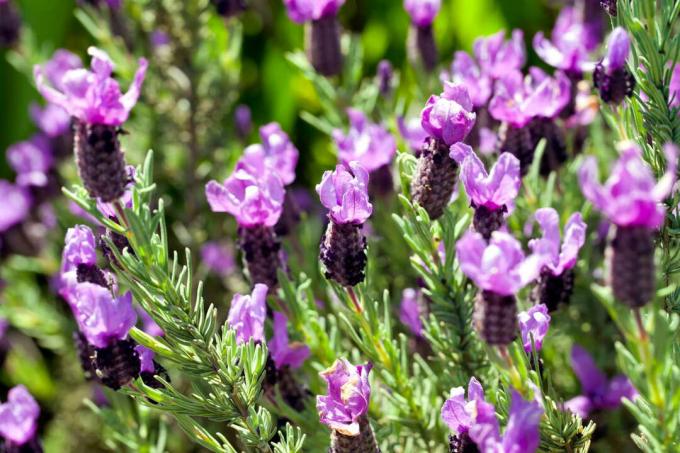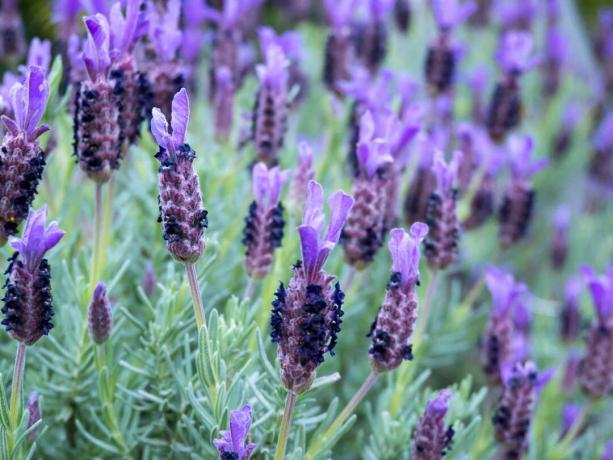With proper care, the French lavender delights with eye-catching inflorescences. We show how to properly cut French lavender and overwinter.

the French lavender (Lavandula stoechas) belongs to the mint family (Lamiaceae). He is related to the famous real lavender (Lavandula angustifolia) and the spike lavender (Lavandula latifolia). Nevertheless, the French lavender stands out thanks to its striking, large bracts at the top of the inflorescence. Depending on the variety, these can appear in pure white, strong purple or radiant violet. They can also differ in color from the actual flowers arranged in spikes and, depending on the variety, unleash a real spectacle of color during the course of flowering. We will show you how you can benefit from the flowering of the French lavender for a long time with the right care measures.
contents
- Caring for French lavender: This is how a lush bloom is created
- Cut French lavender
- Pour and fertilize the French lavender
- Overwinter the French lavender
Caring for French lavender: This is how a lush bloom is created
Normally, the French lavender delights us with its blooms until August or even September. But sometimes it just doesn't want to bloom and only a few, small or none of the ornamental inflorescences appear. This can have various reasons and is completely avoidable with the right care. In particular, regular pruning to prevent the shoots from becoming woody and a small dose of fertilizer from time to time are essential for rich flowering. But the right location should also be given, because the French lavender prefers lime-poor soil.
Everything about the right location and the Planting French lavender find out here.
Cut French lavender
The French lavender is a Mediterranean shrub. It tends to become woody in the lower part of the plant. If the labiate plant is not regularly kept in shape by pruning, only old, woody and bare shoots remain. The bush becomes shapeless over the years and loses the strength for abundant and beautiful flowering. The best time to keep the French lavender in shape is early spring. As soon as it sprouts, half to two-thirds of the length of the shoot should be cut off with sharp hand hedge shears. However, it is important to ensure that you do not cut back into the heavily woody, bare part of the plant. Then it may be that the French lavender no longer sprout.

Under no circumstances should you cut in autumn - this only reduces the already rather low winter hardiness of the French lavender by creating easy entry points for the frost through the interfaces. If the French lavender only produces a few flowers in the summer, flowering can be stimulated in the short term by pruning in the summer. The following applies here: Cut off a maximum of one third of the shoot length and young shoots will quickly sprout powerfully.
Tip: Always remove the withered inflorescences of the French lavender directly - this can have a prolonging effect on the flowering period.
Pour and fertilize the French lavender
When growing in the bed, the French lavender does not need to be watered, or only rarely, except during longer periods of drought. If it is cultivated in a pot, it needs to be watered noticeably more regularly. It is important to keep the substrate evenly moist, but not wet. In the bed, some organic long-term fertilizer such as horn shavings, dung or bone meal is worked into the soil in the spring before they sprout. Malnutrition is mainly visible through fewer flowers. To prevent this from happening, you can start with our primarily organic at the beginning of budding Plantura organic universal fertilizer be helped, which supplies the French lavender with nutrients in the long term.
Overwinter the French lavender
The French lavender is in comparison to its relatives from the genus Lavandula less hardy. Only with luck does it survive temperatures below -5 °C. That's why you should think early on about how to get your French lavender through the winter so that it can continue to inspire with its flowers next year. A cool but bright spot in the house is best.

However, you should not spoil the frost-sensitive French lavender too much. As long as the worst of the frost is over and the sun's rays are clearly gaining strength again, nothing can happen to the French lavender outdoors, at least during the day. Nevertheless, it should be protected with fleece or fir branches, especially at night - and generally when no suitable sheltered place for hibernation is available. If you take the cold problem of French lavender to heart, but at the same time don't spoil it too much, you can create a robust one A plant that is guaranteed to reward the caring care after the cold period with a long and rich flowering.
Like real lavender, French lavender is also very popular because of its aroma. As drying lavender to store it better, you will learn in this article.
